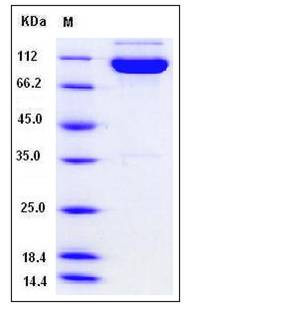Human EphA4 Protein (His & Fc Tag)
HEK8,SEK,TYRO1
- 100ug (NPP3832) Please inquiry
| Catalog Number | P11314-H03H |
|---|---|
| Organism Species | Human |
| Host | Human Cells |
| Synonyms | HEK8,SEK,TYRO1 |
| Molecular Weight | The recombinant human EPHA4/Fc chimera is a disulfide-linked homodimer. The reduced monomer consists of 776 amino acids and predictes a molecular mass of 86.5 kDa. In SDS-PAGE under reducing conditions, the apparent molecular mass of rh EPHA4/Fc monomer is approximately 100-110 kDa due to high levels of glycosylation. |
| predicted N | Val 20 |
| SDS-PAGE |  |
| Purity | > 92 % as determined by SDS-PAGE |
| Protein Construction | A DNA sequence encoding the human EPHA4 (NP_031962.2) extracellular domain (Met 1-Thr 547) was fused with the C-terminal polyhistidine-tagged Fc region of human IgG1 at the C-terminus. |
| Bio-activity | Measured by its binding ability in a functional ELISA . Immobilized human EPHA5 at 20 μg/ml (100 μl/well) can bind human EFNA4-Fc with a linear ranger of 1.28-32 ng/ml. |
| Research Area | Signaling |Signal Transduction |Receptor Tyrosine Kinases (RTKs) |
| Formulation | Lyophilized from sterile PBS, pH 7.4 1. Normally 5 % - 8 % trehalose and mannitol are added as protectants before lyophilization. Specific concentrations are included in the hardcopy of COA. |
| Background | EPH receptor A4 (ephrin type-A receptor 4), also known as EphA4, belongs to the ephrin receptor subfamily of the protein-tyrosine kinase family which 16 known receptors (14 found in mammals) are involved: EPHA1, EPHA2, EPHA3, EPHA4, EPHA5, EPHA6, EPHA7, EPHA8, EPHA9, EPHA10, EPHB1, EPHB2, EPHB3, EPHB4, EPHB5, EPHB6. The Eph family of receptor tyrosine kinases (comprising EphA and EphB receptors) has been implicated in synapse formation and the regulation of synaptic function and plasticity6. EphA4 is enriched on dendritic spines of pyramidal neurons in the adult mouse hippocampus, and ephrin-A3 is localized on astrocytic processes that envelop spines. Eph receptor−mediated signaling, which is triggered by ephrins7, probably modifies the properties of synapses during synaptic activation and remodeling. Ephrin receptors are components of cell signalling pathways involved in animal growth and development, forming the largest sub-family of receptor tyrosine kinases (RTKs). The extracellular domain of an EphA4 interacts with ephrin ligands, which may be tethered to neighbouring cells. Ligand-mediated activation of Ephs induce various important downstream effects and Eph receptors have been studied for their potential roles in the development of cancer. |
| Reference |
